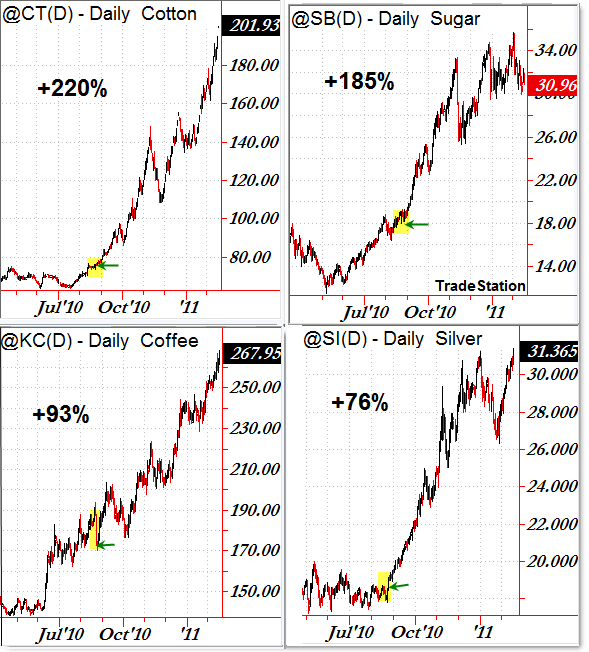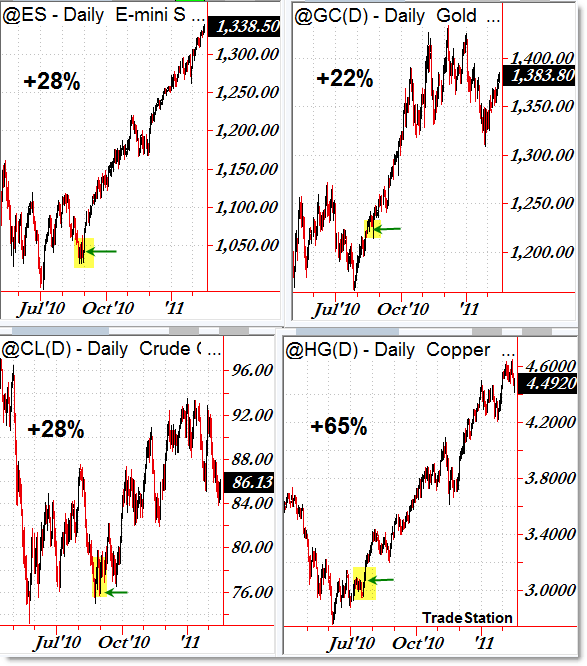Charting the Cross Market Inflation Fallout from QE2 Stimulus
The topic of QE2 and endlessly rising markets has been the talk of the town lately – and for very good reason.
Let’s take a quick objectively look at some of the cross-market charts with a focus on trend and percentage change since the July period, including August 27th when the first rumors of QE2 began.
You know that markets are up, but do you know by how much? You might very well be surprised.
Here’s the big winners from mid-2010 to present:

The logic of the charts is the following:
1. I calculated the estimated percentage change from the price low on the chart to the respective recent peak
2. I highlighted the August 27th period, which is the beginning of the “QE2 Rumors” (Jackson Hole Speech)
3. Charts are using continuous futures contract data from TradeStation
I’ll let the charts speak for themselves. The big winner is Cotton – which moved from the $65 level at the end of July 2010 to the present $200 level hit today.
Sugar also won big from the QE2 time period, though like Cotton, the rally began ahead of the Bernanke “Jackson Hole” speech on August 27th.
The great morning brew coffee moved also ahead of August, bottoming in late May 2010 at the $140 level – price is now up to $270 – up $100 from the end of August when price slammed the $170 level.
Finally, Silver has crushed gold during this time, moving from $18 per ounce right as QE2 rumors began from Chairman Bernanke to the present new high today at $31.36 per ounce.
Here’s the next batch of quad-charts – a little less stellar than those above:

Though a lot of headlines speak of Gold’s stellar rise, the rally during the QE2 period really isn’t that impressive – when put in context of silver at least. Gold rallied 22% from its late July low.
Stocks (shown above in the S&P 500 e-mini futures contract) are up 28% as is oil when traced to its $93 level peak (I traced the percentage gain to the HIGH – not the last price).
Like Silver, copper was a big winner, skyrocketing at the end of August from the $3.00 level to the recent $4.6 level – up 65%.
I’m not here to make any sort of political statement – only to listen to the message of the cross-markets and recent price action.
For reference, Chairman Bernanke announced the official $600 billion number (purchasing Treasuries and Mortgage Backed Securities) on November 3rd, 2010 and the official QE2 injections/activities began November 15th and are slated to continue until around June 2011 – barring any changes in announced Fed policy.
It’s pretty impressive and has changed the way the short-term game is played… but that is another story.
Corey Rosenbloom, CMT
Afraid to Trade.com
Follow Corey on Twitter: http://twitter.com/afraidtotrade
Corey’s new book The Complete Trading Course (Wiley Finance) is now available!

Why isn't the market discounting a possible removal of liquidity in June? Does it think there will be another round?
Good question!
The going thought seems to be that the markets will turn down one to three months ahead of the end of the QE2 purchasing plan just as they turned up about two/three months ahead of the actual QE2 beginning.
That puts us in the April/May timeframe which is still about two months away. What's weird is that the economy really is recovering but the QE2 policies continue – sort of like pouring lighter fuel on a burning fire – so perhaps it's not so surprising in that context that we get these wild rallies in that context.
I've heard rumors that if the Fed is still not pleased with high unemployment and what they consider low inflation (excluding food and energy prices), then we could see a third round of stimulus so… we'll cross that bridge in a few months.
Hi Corey
Just a general question about your two se ups that you discuss in your book; the impulse buy/sell and the cradle……. I am wondering if you have any edge based stats on them? I am debating whether I should add them to my own set ups but just wanted to know what stats (win/loss rates) you have gathered on them while trading them in the past few years? thanks.